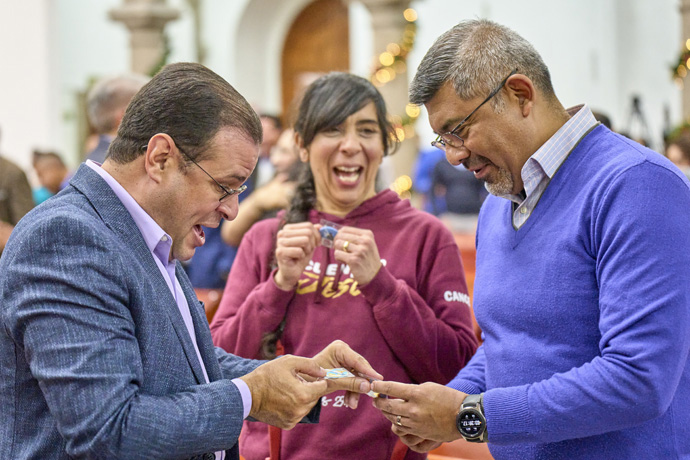December 8, 2023

As Mexican Methodists gathered in their country’s capital to celebrate the 150th anniversary of their founding by Methodists from the United States, they’re not just gazing back with nostalgia. They’re looking at how their Wesleyan heritage can better equip them to face current challenges ranging from artificial intelligence to the climate crisis.
“We wanted to create a space where to talk about the past was to talk about the present, but also to look with hope toward the future,” Bishop Agustín Altamirano Ramos told United Methodist News.
The principal architect of the Nov. 30-Dec. 3 anniversary conference, Altamirano serves the Mexico Annual Conference. One of six annual conferences in the country, it is based in Mexico City.
“This celebration should be like a trampoline that drives and pushes us forward, that challenges us to reflection, and also to action, because too often our reflection doesn’t go anywhere. We Methodists in Mexico see the future with hope. There may be difficult situations like those we’ve experienced in the past, but here we are. We believe the church still has a lot to give, still has a lot to teach, still has a lot to do so that the world will come to know God,” he said.

The Methodist Church of Mexico dates to the middle of the 19th century, when Liberal reformers under President Benito Juarez opened the country to missionaries from denominations other than the Roman Catholic Church, which had enjoyed exclusive economic and political power since the Conquest.
Although even earlier outreach efforts emerged from Methodists in Texas and Methodist miners who migrated from England, the church got its formal start in 1873 when missionaries from the Methodist Episcopal Church landed in Mexico City and purchased a former Franciscan convent on Gante Street that had earlier been confiscated by the government. The missionaries converted it into a church and an orphanage.
The same year, the first Mexican ordained by the Methodist Episcopal Church South came to Mexico City as a missionary, initially collaborating with the church on Gante Street. He soon moved into another former Catholic facility a few blocks away that the Methodist Episcopal Church South purchased in 1873 to house its own work.
For almost 60 years, the two Methodist mission efforts carried out their own projects, the southern U.S. Methodists working primarily in the north of Mexico while the northern U.S. Methodists worked primarily in the south of the country. In 1930, years ahead of their colleagues in U.S. churches, the two mission churches joined together into one autonomous Mexican denomination.
While the Methodist Church of Mexico has enjoyed a special concordat relationship with The United Methodist Church, the relationship has been troubled of late by spillover from the disaffiliation movement in the U.S. Some Mexican Methodists have argued for a break in the relationship.
Yet when plans were made to celebrate the 150th anniversary of the church, an invitation was extended to the Council of Bishops, which sent Bishop Sally Dyck and Bishop Héctor A. Burgos-Núñez to share in the celebration at the church on Gante Street.
“When we received the invitation, we were just delighted. We hope it is the beginning of a growing and strengthened relationship with the Methodist Church of Mexico,” said Bishop Dyck, who is retired but serves as the ecumenical officer of the Council of Bishops.

Bishop Burgos-Núñez, assigned to the Upper New York Area, agrees.
“There’s a clear sense of new possibilities, not only here in the Mexico Annual Conference, but as we have been engaging other bishops, there is a sense of a new day of possibilities that goes beyond generic perceptions of what that relationship can look like,” he said.
“What can we learn from them? How can we do things in new ways? There are so many commonalities in our challenges and our ministries, and there are so many great things that are happening here in Mexico that we can learn from. And then we can also share some of our own learnings in return. I’m personally excited about what this could look like in the future.”
Following several days of presentations and panel discussions, Burgos-Núñez said he was impressed with what he witnessed.
“I see a church that is very intentional about allowing their history to inform their journey of faith. It was very clear in conversation with leaders, pastors and laity that their history is integral to their discipleship. There’s a strong sense of identity, of who they are. We need more of that,” he said.
“I also appreciate, as a Hispanic Latino myself, how clearly people are able to communicate the beauty of how our Wesleyan tradition combines personal piety and social justice. It feels so natural with them.”

The two bishops, along with representatives from The Methodist Church in Britain and the Council of Evangelical Methodist Churches in Latin America and the Caribbean, participated in a variety of activities during their stay, including preaching during Sunday worship services around the city on Dec. 3.
Dyck preached at the Messiah Methodist Church, where she noted how Jesus is characterized as a door, not a wall, in the Gospels.
“It’s heartbreaking for many in The United Methodist Church, and for many in the United States, that there is a movement toward building a border wall between our two countries. Walls exclude. Walls keep people out. Walls block the flow of relationships, economies and even the natural creation like animals. Walls block hearts and block love between people,” she said in her sermon.
“Bring down the walls between the United States and Mexico. Bring down any walls between The United Methodist Church and the Methodist Church of Mexico. Bring down the walls and let’s open the doors!”



